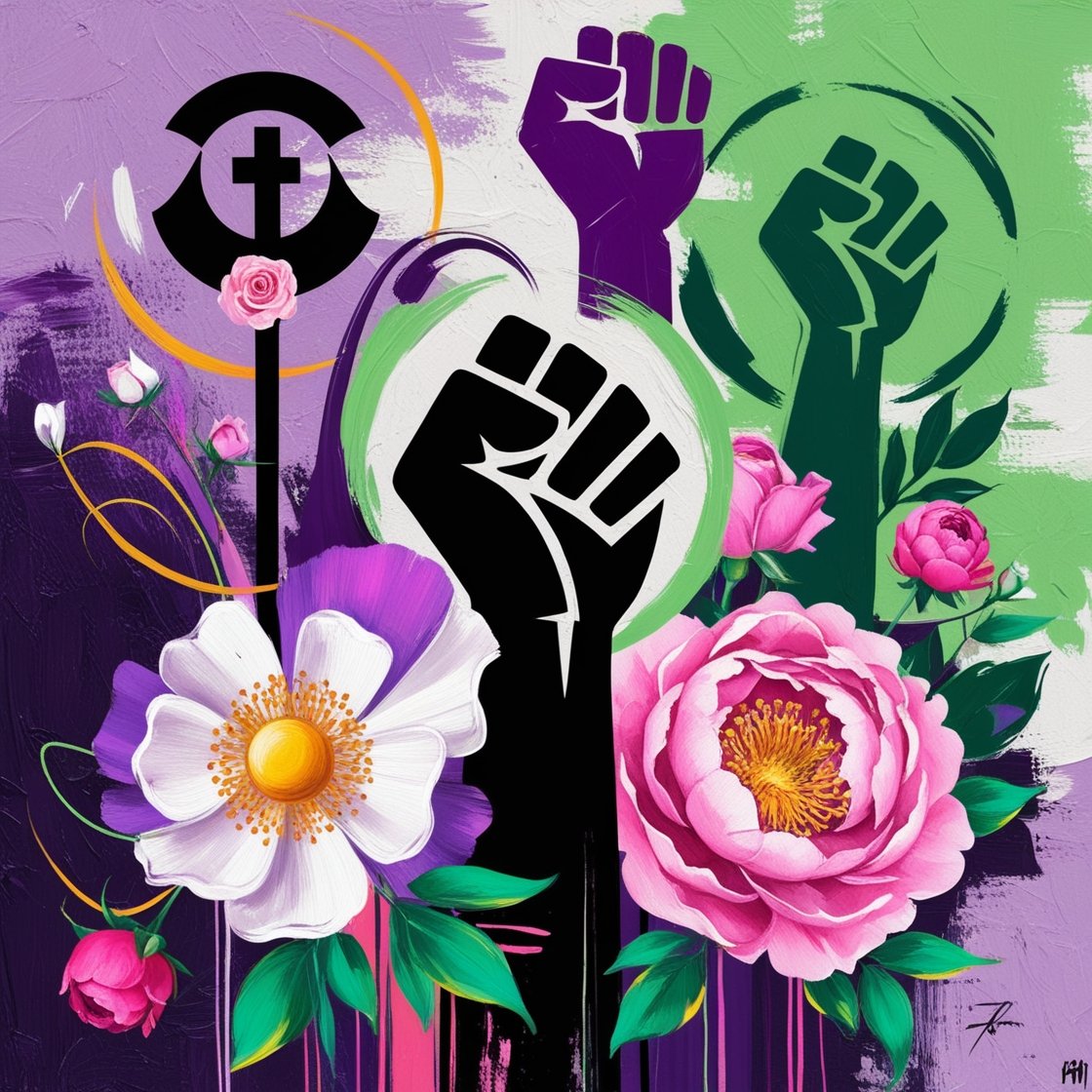Feminist Symbolism In Art
Feminist Symbolism in Art: Meaning and Representation
Understanding Feminist Symbols From Historical Roots to Modern Art
Key Takeaways
Feminist symbolism in art refers to symbols and imagery that convey empowerment, equality, and resilience within feminist narratives.
Flowers symbolize growth, beauty, and resilience, making them powerful symbols in feminist art that celebrate the strength of womanhood.
Feminist symbolism has evolved from traditional images of femininity to include various symbols that reflect modern feminist values.
The female body in feminist art represents autonomy, strength, and identity, challenging objectification and celebrating diversity.
Nature symbolizes growth, resilience, and connection, aligning with ecofeminist ideals that link the protection of nature with women’s rights.
Feminist Symbolism in Art: Meaning and Representation
Art has long served as a platform for social and political expression, with feminist symbolism taking a central role in challenging gender norms and celebrating the complex experiences of women. Feminist symbolism in art acts as both a tool of resistance and a means of reshaping cultural narratives. Through powerful depictions of the female body, natural symbols like flowers, or potent protest imagery, artists use feminist symbolism to elevate the message of equality, empowerment, and self-determination. In doing so, they create works that resonate deeply, inspiring generations of women and advocates.
Iconic Feminist Symbols Meaning and Evolution in Art
Understanding Feminist Symbolism in Art
Feminist symbolism refers to using symbols and imagery to represent empowerment, autonomy, and equality in feminist art. Through distinct iconography, artists convey messages that address issues such as body autonomy, gender stereotypes, and solidarity. This symbolism is often rooted in historical and cultural narratives, which are transformed through a feminist lens to confront and subvert societal expectations.
Historical Context of Feminist Symbolism in Art
Early Feminist Art and Symbolism
Feminist symbolism in art began with early movements aimed at challenging patriarchal structures. During the suffragette movement, for example, artists used icons like the female figure and floral motifs to emphasize themes of courage and collective power.
The Rise of the Feminist Art Movement
In the 1970s, the feminist art movement expanded these symbols, bringing greater focus to the female body, labor, and autonomy. Artists like Judy Chicago and Miriam Schapiro broke barriers by exploring female identity and reinterpreting traditional feminine symbols.
Feminist Symbol Jewelry From Earrings to Necklaces as Statements of Empowerment
Common Themes in Feminist Symbolism
Artistic symbols used in feminist work often revolve around resilience, unity, and self-empowerment themes. These themes become visual narratives that resonate with women across different generations and cultures.
Resilience and Rebirth in Feminist Art
The concept of rebirth is a recurring theme in feminist art. Symbols like the phoenix and the lotus flower, representing growth through adversity, have become iconic in representing women’s resilience in the face of societal obstacles.
Symbols of Unity and Solidarity
Unity and solidarity are often represented by hands or floral wreaths, expressing the interconnectedness of women’s experiences and struggles. These symbols encourage collective empowerment and celebrate the bonds that form within feminist movements.
The Evolution of Feminist Iconography
Feminist iconography has continually evolved to reflect shifts in feminist thought. For instance, the portrayal of the female body has transformed from objectified depictions to symbols of strength and autonomy.
From Body Autonomy to Empowerment
Feminist art depicts the female body as a powerful expression of self-ownership and agency. Rather than adhering to traditional standards, artists embrace the diversity and individuality of female forms as symbols of empowerment.
Subverting Traditional Female Imagery
By reclaiming images historically used to reinforce stereotypes, feminist artists subvert these portrayals to celebrate women’s strength, individuality, and resilience.
The Power of Feminist Art Symbols of Empowerment and Social Justice
Key Symbols of Feminism in Art
Certain symbols are closely associated with feminist art, each with unique significance within feminist narratives.
Floral Symbolism in Feminist Art
Flowers like the rose, daisy, and lotus appear frequently in feminist art, symbolizing femininity, resilience, and the beauty of growth. The rose represents strength and passion, while the lotus signifies rebirth and triumph over adversity.
The Power of the Female Body as a Symbol
The female form, often represented in various stages of life or activity, symbolizes freedom, independence, and self-expression. When used in feminist art, the female body breaks from objectification and becomes a testament to strength and identity.
Hands as Symbols of Solidarity and Labor
Hands are a significant motif in feminist symbolism, representing solidarity, labor, and collective effort. This imagery often portrays women united, symbolizing their strength and commitment to societal change.
The Moon and Reproductive Rights - AI Art By Monica Brinkman
The Moon and Feminine Cycles
The moon is frequently associated with feminine energy, cycles, and reproductive rights. It symbolizes a connection to nature, fertility, and the rhythms of life, reinforcing the natural power of femininity.
The Moon and Reproductive Rights
In feminist art, the moon can represent bodily autonomy and reproductive rights, reflecting women’s natural authority over their bodies.
Nature as a Feminist Symbol
In all its forms, nature is an essential element in feminist symbolism. Through images of plant growth, forests, and rivers, artists depict the connection between women and nature and the strength inherent in both.
Growth and Resilience Through Botanical Imagery
Botanical imagery, such as vines and roots, represents resilience and a deep-rooted connection to the earth. This connection often aligns with ecofeminist ideals, which link the exploitation of nature with the oppression of women.
Modern Feminist Symbols in Art
Today, feminist symbols are seen in various forms of protest art, from digital designs to street art. They represent messages of empowerment and are a rallying cry for unity and justice.
Exploring Contemporary Feminist Artists
Modern artists continue to evolve the language of feminist symbolism, using diverse media to depict womanhood and challenge social constructs. This shift has led to a broader acceptance of feminist art, making it more accessible globally.
Feminist Symbols in Art: How Artists Use Iconography to Advocate for Equality
Feminist Symbolism Across Different Cultures
While certain symbols are globally recognized, feminist art also incorporates cultural symbols that add depth to the narrative. For instance, Indigenous feminist art may use traditional symbols to highlight the experiences and rights of Indigenous women.
Impact of Feminist Symbolism on Modern Art
Feminist symbolism has profoundly influenced modern art, inspiring new generations of artists. It serves as both a reminder of women's struggles and a vision of the future they strive to achieve.
The Legacy of Feminist Symbolism
Feminist symbolism in art is an enduring language of empowerment, resilience, and solidarity. These symbols resonate across cultures and generations, serving as reminders of the ongoing journey toward equality. As feminist art continues to evolve, so does its powerful symbolism, forever shaping how society perceives gender, strength, and unity.
Thank you for joining me in exploring the dynamic and powerful world of feminist symbolism in art. It’s inspiring to witness how symbols continue to shape narratives of equality, resilience, and hope.
Warmly,
Monica Brinkman, Artist and Creator of FeministART.ca








